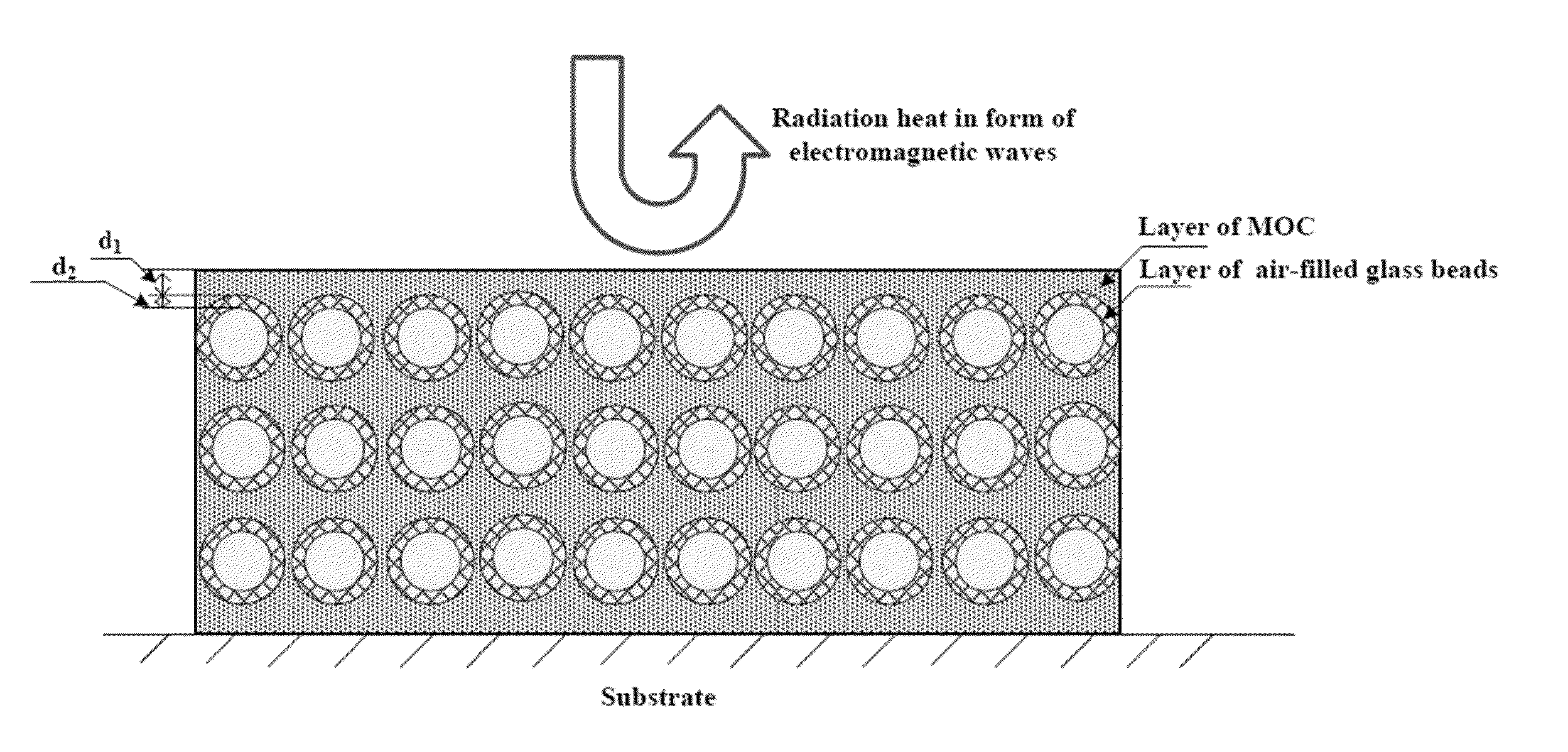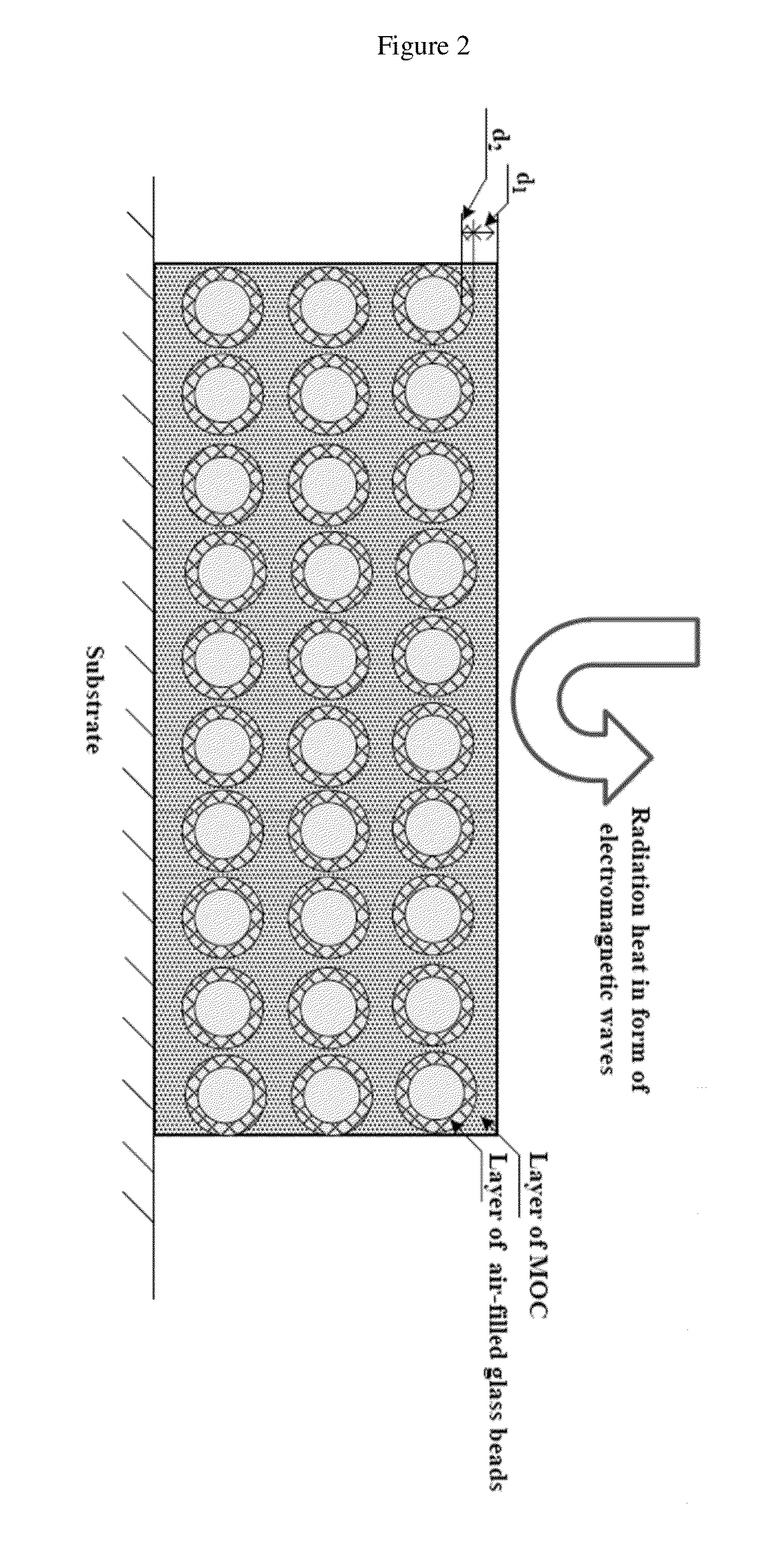Advanced inorganic material for reflection of electromagnetic waves
a technology of electromagnetic waves and inorganic materials, applied in heat-proofing, building components, construction, etc., can solve the problems of shortening the working life of materials, not having sufficient mechanical strength to support a large load, and material loss of function, so as to reduce the temperature difference, shorten the working life, and increase the thermal stress
- Summary
- Abstract
- Description
- Claims
- Application Information
AI Technical Summary
Benefits of technology
Problems solved by technology
Method used
Image
Examples
example 1
[0062]The raw materials used are MgO, MgCl2 emulsion, water, KH2PO4 and air-filled glass beads. MgO used was calcined magnesite powder with a purity of 94%. Magnesium chloride hexahydrate crystal (MgCl2. 6H2O) with a purity of 98% was employed for making MgCl2 solution. KH2PO4 in chemical grade was employed. AGE with density of 0.38 g / cm3 and mean particle size of about 40 μm were used. Refractive index of AGB is 1.51, and their typical wall thickness is around 431 nm. Tap water was used for coating mixing. The constituents of an embodiment of the present invention are shown in Table 1. Powders of MgO, and AGB were uniformly mixed together first. Then, this well mixed powder was further homogenously mixed with MgCl2 solution that had KH2PO4 already dissolved. Fiber cement board that is a combination of cement and reinforcing fibers was used as coating substrate. By using scrape coating method, the present invention was applied onto the surface of a 200 mm×200 mm×8 mm fiber cement bo...
example 2
[0063]The raw materials used are MgO, MgCl2 solution, water, KH2PO4, air-filled glass beads and titanium dioxide. MgO used was calcined magnesite powder with a purity of 94%. Magnesium chloride hexahydrate crystal (MgCl2.6H2O) with a purity of 98% was employed for making MgCl2 solution. KH2PO4 in chemical grade was employed. AGB with density of 0.38 g / cm3 and mean particle size of about 40 μm were used. Refractive index of AGB is 1.51, and their typical wall thickness is 431 nm. TiO2 used was in rutile crystal form and had mean particle size of 0.41 ram. TiO2 is a commonly used white pigment coating materials and is used for increasing coating viscosity and durability of this invention. The constituents of an embodiment of the present invention (CBT) are shown in Table 1. Powders of MgO, AGB and TiO2 were uniformly mixed together first. Then, this well mixed powder was further homogenously mixed with MgCl2 solution that had KH2PO4 dissolved. Fiber cement board that is a combination ...
example 3
[0064]The raw materials used are MgO, MgCl2 solution, water, KH2PO4, AGB and yellow pigment. MgO used was calcined magnesite powder with a purity of 94%. Magnesium chloride hexahydrate crystal (MgCl2.6H2O) with a purity of 98% was employed for making MgCl2 solution. KH2PO4 in chemical grade was employed. AGB with density of 0.38 g / cm3 and mean particle size of about 40 μm were used. Yellow pigment used had Fe2O3 as main component and is for aesthetic purposes in this invention. Tap water was used for coating mixing. The proportion of each constituent in an embodiment of the present invention (CBY) is shown in Table 1. Powders of MgO, AGB and yellow pigment were uniformly mixed together first. Then, this well mixed powder was further homogenously mixed with MgCl2 solution that had KH2PO4 dissolved. Fiber cement board that was a combination of cement and reinforcing fibers was used as coating substrate. By using scrape coating method, the present invention was applied onto the surface...
PUM
| Property | Measurement | Unit |
|---|---|---|
| Thickness | aaaaa | aaaaa |
| Thickness | aaaaa | aaaaa |
| Thickness | aaaaa | aaaaa |
Abstract
Description
Claims
Application Information
 Login to View More
Login to View More - R&D
- Intellectual Property
- Life Sciences
- Materials
- Tech Scout
- Unparalleled Data Quality
- Higher Quality Content
- 60% Fewer Hallucinations
Browse by: Latest US Patents, China's latest patents, Technical Efficacy Thesaurus, Application Domain, Technology Topic, Popular Technical Reports.
© 2025 PatSnap. All rights reserved.Legal|Privacy policy|Modern Slavery Act Transparency Statement|Sitemap|About US| Contact US: help@patsnap.com



